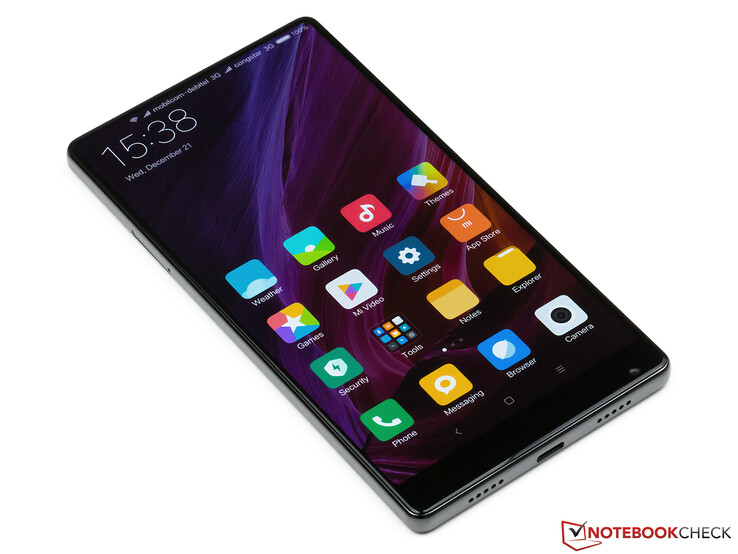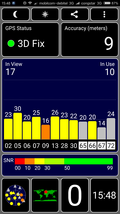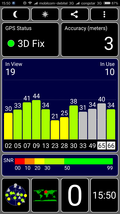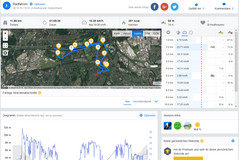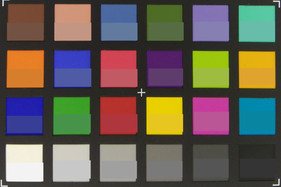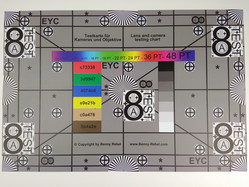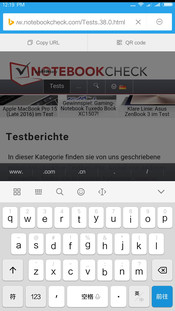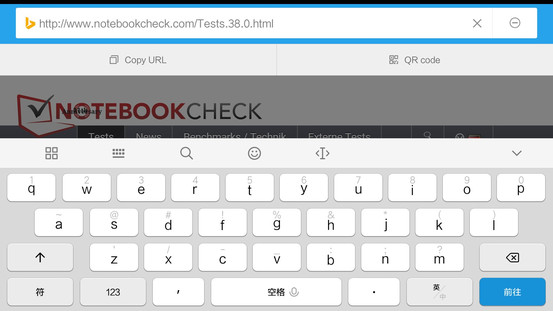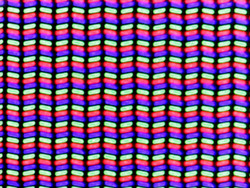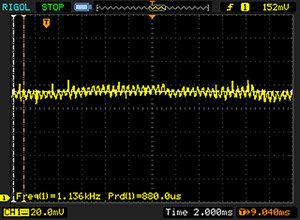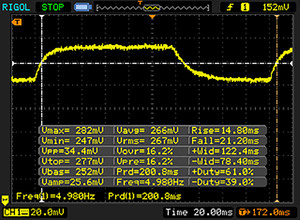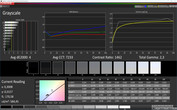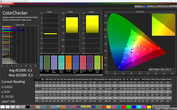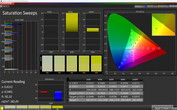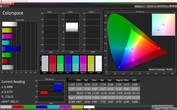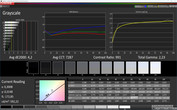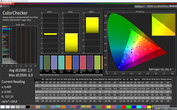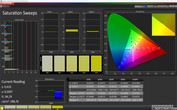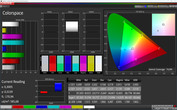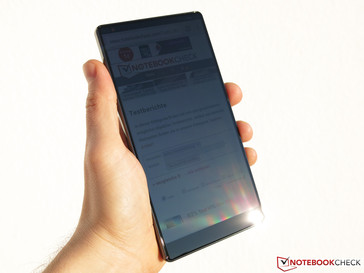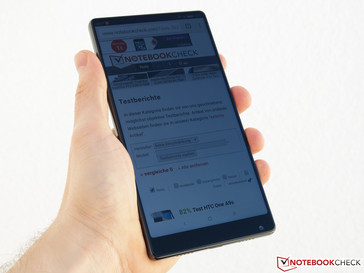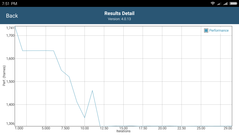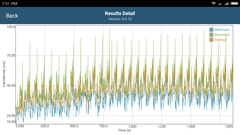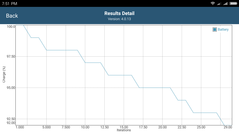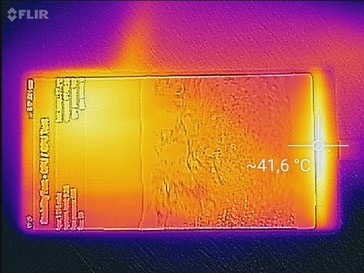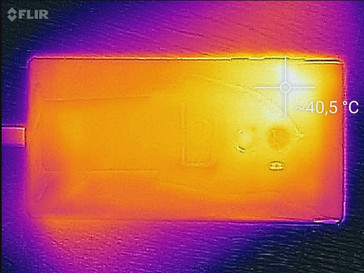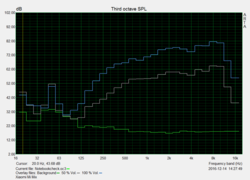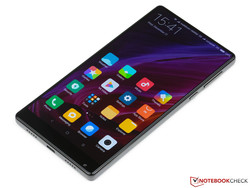Xiaomi Mi Mix Phablet Review
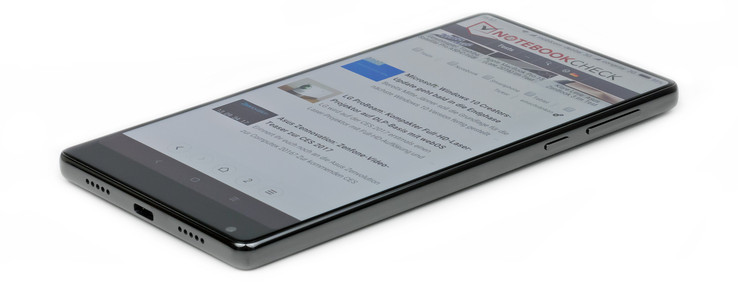
For the original German article, see here.
Xiaomi's Mi Mix offers both a much higher viewing space and work surface than most competitors with a screen diagonal of 6.4-inches. The narrow display bezel on three sides prevents it from getting out of control. A sound-producing piezo-ceramic part behind the display is responsible for sound production since there was no room for an earpiece. Other high-quality components, in the forms of a Snapdragon 821 SoC, 128 GB of storage and 4 GB of RAM, are also installed in the review sample's black ceramic casing.
While the sales figures of the products by the Chinese company Xiaomi are situated in the top ranks in its country, the devices are not officially available in Europe. However, they can be ordered in Germany via importers. The review sample is available for approximately 680 Euros (~$716). Shipping and possible taxes have to be added to this. A version with 256 GB and 6 GB of RAM is also available for 40 Euros (~$42) more.
A serious competitor of the Mi Mix in the phablet sector is the brand-new Huawei Mate 9. However, since the competition hardly offers any up-to-date models, we use Samsung's Galaxy S7 Edge, Google's Pixel XL and the OnePlus 3T alongside several Android smartphones for comparison. Apple's iPhone 7 Plus and Microsoft's Lumia 950 XL also participate in this test.
Case
The seamless bezel around the phablet and its back is made of gray-black ceramic. The glossy material feels glass-like due to the sleek surface. However, it proved to have a considerably higher scratch-resistance than the touchscreen, which had several blemishes that could be felt with a fingernail by the end of our test. Our review sample supplier includes a screen protector for sold products - a sensible preventive measure although the fine scratches are first visible in direct sunlight.
Although it is made of several parts, the Mi Mix looks as if it has been made from one piece thanks to impeccably rounded transitions, a flush-fitted camera unit and the overall sleek materials. However, its fingerprint susceptibility and tendency to slide on slightly inclined surfaces or when held by moist hands are drawbacks. The leather casing that Xiaomi includes ex-factory can prevent this. It also offers a certain degree of shock protection - especially since the edgeless design and ceramic bezel demand particular caution.
At 158.8 x 81.9 x 7.9 millimeters and 209 grams, the Mi Max is the biggest and heaviest device in the comparison, but the differences are relatively moderate in view of the huge screen. Thanks to its narrow display bezel, it is only 0.6 millimeters longer and 4 millimeters wider than the iPhone 7 Plus with a 5.5-inch screen. The relatively high weight adds to the review sample's high-quality feel. The casing's very high torsional stiffness additionally underlines this. Minor wave formation on the LCD screen is visible only when applying high pressure to the touchscreen.
Connectivity
Besides a conventional 3.5-mm headset jack, Xiaomi's Mi Mix also comes with a reversible USB Type-C port. The latter only supports the older USB 2.0 standard, and thus data can only be transferred at approximately 35 MB/s maximum. However, USB OTG for connecting peripherals is supported. Although the storage of the Mi Mix cannot be expanded via micro-SD card, a generous 119 GB of internal storage is available ex-factory.
In addition to both nano-SIM slots for connecting to mobile wireless networks, AC Wi-Fi including Wi-Fi Direct, Bluetooth 4.2, and NFC for wireless data transmission is onboard. Video and audio outputs via Miracast are also supported.
Despite the limited room on the handset's front, Xiaomi has placed a small RGB notification LED in the center below the screen. Furthermore, a fingerprint scanner that reliably activates and unlocks the device is found on the back.
Software
Xiaomi relies on the Android 6.0.1 operating system with the MIUI 8.0 in its Mi Mix. The good availability of OTA security updates was noticed positively in the test. The relatively up-to-date security patch from November 1, 2016 was updated to that of December 1, 2016 - exemplary!
The user interface varies both in terms of function and looks from stock Android. For example, it does not have an app drawer and all installed programs are placed directly on the home screen. A quick-access button that can completely replace the navigation bar is also enabled by default. The system can generally be customized extensively: For example, the back button can be placed on either the left or right of the home button according to personal preference. Other useful additional features are a kid's mode that only allows accessing pre-defined apps and the "Dual Apps" function that installs programs twice so that they can be used independently from one another. An optional one-hand mode facilitates using the handset.
Since the Mi Mix is not intended for the European market, a German language package is not supported. English, however, can be selected but many system apps still display Chinese fonts. As is common in China, the device is delivered without Google services and the Mi App Store is installed instead. Xiaomi preloads many apps on the phablet ex-factory, most of which cannot be used in Europe or are simply not translated. Fortunately, all except some proprietary apps can be uninstalled. Users can install system ROMs designed for European conditions or at least download Google's Play Store.
Communication and GPS
Xiaomi's Mi Mix generally supports connections via LTE networks for mobile data transmission. However, the imported device cannot transmit in band 20 that is important for Germany and other European countries. Nevertheless, the SIM card configured for Internet access connects to matching 4G networks when available, and the other slot utilizes 3G and 2G networks. We do not have any reliable information concerning the maximum transmission speeds in mobile wireless networks.
The review sample uses the latest AC-standard for communicating with local Wi-Fi networks. We achieved 289 Mbit/s in receive and 234 Mbit/s in send using our Linksys EA8500 reference router. The first is enough for a midfield position and is roughly on par with Samsung's Galaxy S7 Edge premium smartphone. Only devices with MIMO technology, such as Google's Pixel XL or Apple's iPhone 7, are superior in this aspect. The Mi Mix slips downward in the ranking when sending data, but it is still always better than Huawei's Mate 9 phablet competitor. The Wi-Fi module's range was inconspicuously good.
Beyond that, Bluetooth 4.2 and NFC are present for wireless data transmission.
| Networking | |
| iperf3 transmit AX12 | |
| Apple iPhone 7 (Klaus I211) | |
| Google Pixel XL 2016 | |
| Samsung Galaxy S7 Edge | |
| OnePlus 3T | |
| Xiaomi Mi Mix | |
| Huawei Mate 9 | |
| iperf3 receive AX12 | |
| Apple iPhone 7 (Klaus I211) | |
| Google Pixel XL 2016 | |
| Xiaomi Mi Mix | |
| Samsung Galaxy S7 Edge | |
| Huawei Mate 9 | |
| OnePlus 3T | |
The GPS module in the Mi Mix also supports the Beidou and GLONASS satellite networks. The phablet found our position quickly with an accuracy of up to 3 meters outdoors. It also found our position with a slightly lower accuracy of 9 meters quite fast at roughly 2.5 meters away from the next window indoors.
As usual, we took the review sample alongside Garmin's Edge 500 GPS system on a bike ride. The phablet did a relatively good job. It even traced our route more accurately than Garmin's navigation system in the area of the underpass. However, the Mi Mix was clearly put in its place in the area of the turning point as it took a generous shortcut here. The determined total route deviates by less than 2% so that the Mi Mix should easily suffice for navigating.
Telephone and Call Quality
Xiaomi's phone app features a keypad, call list, and search field for the contact database on its start screen. A second tab in the application displays all saved contacts while a third one called "Yellow Pages" opens various untranslated services and provides information about the mobile data account.
The virtually edgeless design in the upper area did not allow installing a conventional earpiece in the Mi Mix. Instead, a piezo-ceramic part that is incorporated behind the display is responsible for this. We were able to test a similar system in, for example, Gigaset's ME Pro. It did not really convince us at the time. Thus, the good implementation in the review sample is all the more surprising. The hearing area is generous, and the ear does not have to be held to a specific place in order to hear the contact. The loud and clear sound is quite capable of competing with conventionally equipped phones although minor concessions have to be made in terms of naturalness. Background noises are suppressed effectively. The Xiaomi user was always well-intelligible for the contact without interruptions.
The microphones do a decent job in hands-free mode, especially since the powerful, warm-sounding speaker ensures good intelligibility of the contact.
Cameras
The front-facing camera in the Mi Mix has a resolution of 5 megapixels and an aperture of f/2.0. In contrast to the usual design, it is not installed above the screen but is in the lower right corner. Xiaomi recommends simply turning the phablet by 180 degrees in order to not accidentally cover the lens when taking selfies. When preferred, the digital image can be edited either automatically or manually with software filters. Smoothening and brightening skin, enlarging the eyes and slimming the face are possible. Relatively high-detail photos are produced in daylight when all filters are disabled. However, the sharpness decreases visibly indoors. Videos can be recorded in Full HD and they score with decent quality.
Xiaomi installs a 16-megapixel sensor and a lens with an aperture of f/2.2 as the primary camera. The outdoor image quality can compete with those of its rivals. The photos generally display many details without looking blurred (e.g. scene 1). However, this is not true for dark image areas that quickly blend to a single black area. Unfortunately, the manual or automatic HDR mode does not change this. It primarily ensures a higher contrast and more vivid colors. An optical image stabilizer was often wished for indoors since many photos looked a bit blurred due to unstable shots. In return, the short release time is pleasing. Videos can be recorded in a maximum of UHD resolution at 30 frames per second and active auto-focus with the Mi Max. They score with good image quality, but again, the outcome suffers from the lack of an image stabilizer and the photos look relatively unquiet. A mode with 60 frames per minute for recording motion more fluently is not available. However, slow-motion videos can be recorded in a resolution of 1280x720 pixels at 120 frames per second. Their quality is only enough for viewing on small monitors, though.
The camera app can be launched quickly from standby via double-clicking the mute button. In addition to modes like "Beautify", "Panorama" or "Tilt-Shift", it also offers a manual mode that allows freely setting parameters such as white balance, exposure, focal point, and ISO sensitivity. A bug that sets the primary camera's video quality back to "HD" after rebooting the phablet, although "4K" or "Full HD" was selected, is a bit annoying.
To test the color accuracy of the primary camera in Xiaomi's Mi Mix, we compare a photo taken with the X-Rite ColorChecker Passport under defined light conditions with the factual reference colors. The photo is not edited, e.g. manual white balance, afterward. Here, we see that most colors are more intense than in reality.
We test the reproduction performance of the used lens and the resolution capacity of the camera sensor by photographing our test chart in defined artificial light. A slightly reduced resolution is visible at the edges, but this is still within an uncritical range. Single-colored areas look a bit irregular when zoomed and light color fringing is visible in strong contrasts. Overall, a good although not outstanding outcome.
Accessories and Warranty
Besides a Chinese charger including a USB cable, the review sample comes with a black leather case that protects the bezel and the rear from damage. A headset is not in the box. A matching power supply, screen protector, and USB-OTG cable is included when buying Xiaomi's Mi Mix via TradingShenzen, who also provided us with the review sample. Beyond that, the retailer includes a one-year warranty on the phablet's functionality.
Since our review sample is actually intended for the Chinese market, it does not have a CE label. We have summarized information about importing smartphones and phablets in an in-depth news article.
Please see our Guarantees, Return Policies & Warranties FAQ too for country-specific information.
Input Devices and Handling
The review sample's touchscreen is very sensitive everywhere despite its unusually close to the edge design, and fingers also glide over the glass surface easily. When holding the device in landscape mode, accidental inputs via the onscreen buttons are possible due to the display's extremely narrow bezel and depending on the hands' position - however, this rarely happened.
The Chinese-language based Sogou keyboard is preloaded ex-factory for typing. However, it offers a conventional keyboard with an English layout. Since many buttons and functions are not translated, non-Chinese users will probably install another keyboard. It does not even have to be installed from Google's Play Store as apps, such as SwiftKey, can be downloaded via Xiaomi's app store without needing to register.
The fingerprint scanner on the rear of the Mi Mix is easy to reach as long as the phablet is held in one hand. It responds quickly and reliably to the touch. It is also possible to reactivate the handset from standby by double-tapping the touchscreen without having to pick it up. The volume control and power button have a crisp and not too firm pressure point, and they are fitted into their recesses with almost no play. Tapping them lightly causes a slight clattering noise.
As expected in view of the phablet's excellent technical data, the user interface responds very smoothly and almost instantaneously to all user inputs.
Display
The screen in Xiaomi's Mi Max is definitely the handset's biggest eye-catcher. Its diagonal of 6.4-inches makes smartphones with actually quite generous 5.5-inch panels look outdated. Thanks to the unusual 17:9 aspect ratio, faded-in Android navigation buttons can be displayed full-size on 16:9 content. A resolution of 2040x1080 pixels at a pixel density of 361 PPI will no longer win any comparisons, but single pixels are not visible. The display's rounded corners that incorporate it even more successfully into the casing's design are unusual.
With up to 577 cd/m² in the screen's center on a completely white surface, the panel achieves a high brightness and good contrast ratio of 1374:1. It does not matter whether the ambient light sensor is enabled. The brightness drops to 530 cd/m² when dark and bright areas are realistically distributed over the screen (average picture level / APL50). At the same time, the black level increases marginally from 0.38 cd/m² to 0.42 cd/m², which results in a slightly reduced contrast ratio of 1262:1. When looking at the brightness rates in manual settings, the review sample ends up in second place behind Huawei's Mate 9. Some rivals with automatic settings offer a bit more here and in the APL50 test. The illumination of 89% is decent, and subjectively, only a tiny bright spot is visible in the lower right corner on a black screen. PWM is used at a relatively high frequency of 1136 Hz at a screen brightness of below 10%.
| |||||||||||||||||||||||||
Brightness Distribution: 89 %
Center on Battery: 530 cd/m²
Contrast: 1374:1 (Black: 0.42 cd/m²)
ΔE ColorChecker Calman: 2.7 | ∀{0.5-29.43 Ø4.78}
ΔE Greyscale Calman: 4.2 | ∀{0.09-98 Ø5}
Gamma: 2.23
CCT: 7287 K
| Xiaomi Mi Mix IPS, 2040x1080, 6.4" | Huawei Mate 9 IPS, 1920x1080, 5.9" | Samsung Galaxy S7 Edge Super AMOLED, 2560x1440, 5.5" | Google Pixel XL 2016 AMOLED, 2560x1440, 5.5" | OnePlus 3T Optic-AMOLED, 1920x1080, 5.5" | Microsoft Lumia 950 XL AMOLED, 2560x1440, 5.7" | Apple iPhone 7 Plus IPS, 1920x1080, 5.5" | |
|---|---|---|---|---|---|---|---|
| Screen | |||||||
| Brightness middle (cd/m²) | 577 | 696 21% | 554 -4% | 402 -30% | 421 -27% | 297 -49% | 557 -3% |
| Brightness (cd/m²) | 576 | 680 18% | 552 -4% | 408 -29% | 430 -25% | 297 -48% | 553 -4% |
| Brightness Distribution (%) | 89 | 93 4% | 96 8% | 85 -4% | 84 -6% | 93 4% | 97 9% |
| Black Level * (cd/m²) | 0.42 | 0.42 -0% | 0.35 17% | ||||
| Contrast (:1) | 1374 | 1657 21% | 1591 16% | ||||
| Colorchecker dE 2000 * | 2.7 | 4.3 -59% | 1.59 41% | 4 -48% | 7.1 -163% | 2.67 1% | 1.4 48% |
| Colorchecker dE 2000 max. * | 6.9 | 9.4 -36% | 2.56 63% | 10.1 -46% | 15.3 -122% | 3.98 42% | 3.1 55% |
| Greyscale dE 2000 * | 4.2 | 4.8 -14% | 2.01 52% | 3.2 24% | 6.8 -62% | 2.81 33% | 1.3 69% |
| Gamma | 2.23 99% | 2.33 94% | 2.01 109% | 2.19 100% | 2.23 99% | 2.08 106% | 2.21 100% |
| CCT | 7287 89% | 7255 90% | 6321 103% | 7037 92% | 7866 83% | 6379 102% | 6667 97% |
| Color Space (Percent of AdobeRGB 1998) (%) | 82.12 | 66.31 | 63.1 | ||||
| Color Space (Percent of sRGB) (%) | 99.98 | 99.79 | 99.83 |
* ... smaller is better
Screen Flickering / PWM (Pulse-Width Modulation)
| Screen flickering / PWM detected | 1136 Hz | ≤ 10 % brightness setting | |
The display backlight flickers at 1136 Hz (worst case, e.g., utilizing PWM) Flickering detected at a brightness setting of 10 % and below. There should be no flickering or PWM above this brightness setting. The frequency of 1136 Hz is quite high, so most users sensitive to PWM should not notice any flickering. In comparison: 53 % of all tested devices do not use PWM to dim the display. If PWM was detected, an average of 8091 (minimum: 5 - maximum: 343500) Hz was measured. | |||
Display Response Times
| ↔ Response Time Black to White | ||
|---|---|---|
| 37.2 ms ... rise ↗ and fall ↘ combined | ↗ 10.4 ms rise | |
| ↘ 26.8 ms fall | ||
| The screen shows slow response rates in our tests and will be unsatisfactory for gamers. In comparison, all tested devices range from 0.1 (minimum) to 240 (maximum) ms. » 95 % of all devices are better. This means that the measured response time is worse than the average of all tested devices (20.2 ms). | ||
| ↔ Response Time 50% Grey to 80% Grey | ||
| 36 ms ... rise ↗ and fall ↘ combined | ↗ 14.8 ms rise | |
| ↘ 21.2 ms fall | ||
| The screen shows slow response rates in our tests and will be unsatisfactory for gamers. In comparison, all tested devices range from 0.165 (minimum) to 636 (maximum) ms. » 49 % of all devices are better. This means that the measured response time is worse than the average of all tested devices (31.6 ms). | ||
The review sample uses automatic contrast control by default. This setting alongside a color temperature of 7233 K results in cool and saturated colors. Although the DeltaE shifts of 4.5 (colors) and 4 (grayscale) are not particularly high in this mode, they are still higher than ideal (<3). The color reproduction does not look as vivid when selecting the "Standard" contrast mode, and the DeltaE shift in colors drops to 2.7 - a good rate. Some smartphones, such as Samsung's Galaxy S7 Edge, Microsoft's Lumia 950 XL, and Apple's iPhone 7 Plus, offer a somewhat more accurate color reproduction.
Performance
Qualcomm's current leading Snapdragon 821 processor ensures enough power in the Mi Mix. It sports four Kyro processing cores, two of which clock at up to 1.6 GHz and the other two clock at up to 2.35 GHz. A powerful Adreno 530 GPU is installed for video output. It has large performance reserves thanks to the screen's moderate resolution.
Since the selected comparison models are all members of the premium range, the review sample does not often reach the top places. It primarily achieves good results in the Geekbench 4 Compute score, the onscreen test of GFXBench, and in 3DMark. On the other hand, it presents weak scores in the overall rating of BaseMark OS II.
| AnTuTu v6 - Total Score (sort by value) | |
| Xiaomi Mi Mix | |
| Huawei Mate 9 | |
| Samsung Galaxy S7 Edge | |
| Google Pixel XL 2016 | |
| OnePlus 3T | |
| Microsoft Lumia 950 XL | |
| Apple iPhone 7 Plus | |
| Geekbench 4.0 | |
| 64 Bit Multi-Core Score (sort by value) | |
| Xiaomi Mi Mix | |
| Huawei Mate 9 | |
| Samsung Galaxy S7 Edge | |
| Google Pixel XL 2016 | |
| OnePlus 3T | |
| Apple iPhone 7 Plus | |
| 64 Bit Single-Core Score (sort by value) | |
| Xiaomi Mi Mix | |
| Huawei Mate 9 | |
| Samsung Galaxy S7 Edge | |
| Google Pixel XL 2016 | |
| OnePlus 3T | |
| Apple iPhone 7 Plus | |
| Compute RenderScript Score (sort by value) | |
| Xiaomi Mi Mix | |
| Huawei Mate 9 | |
| Samsung Galaxy S7 Edge | |
| Google Pixel XL 2016 | |
| PCMark for Android - Work performance score (sort by value) | |
| Xiaomi Mi Mix | |
| Huawei Mate 9 | |
| Samsung Galaxy S7 Edge | |
| Google Pixel XL 2016 | |
| OnePlus 3T | |
| GFXBench (DX / GLBenchmark) 2.7 | |
| T-Rex Onscreen (sort by value) | |
| Xiaomi Mi Mix | |
| Huawei Mate 9 | |
| Samsung Galaxy S7 Edge | |
| Google Pixel XL 2016 | |
| OnePlus 3T | |
| Microsoft Lumia 950 XL | |
| Apple iPhone 7 Plus | |
| 1920x1080 T-Rex Offscreen (sort by value) | |
| Xiaomi Mi Mix | |
| Huawei Mate 9 | |
| Samsung Galaxy S7 Edge | |
| Google Pixel XL 2016 | |
| OnePlus 3T | |
| Microsoft Lumia 950 XL | |
| Apple iPhone 7 Plus | |
| GFXBench 3.0 | |
| 1920x1080 1080p Manhattan Offscreen (sort by value) | |
| Xiaomi Mi Mix | |
| Huawei Mate 9 | |
| Samsung Galaxy S7 Edge | |
| Google Pixel XL 2016 | |
| OnePlus 3T | |
| Microsoft Lumia 950 XL | |
| Apple iPhone 7 Plus | |
| on screen Manhattan Onscreen OGL (sort by value) | |
| Xiaomi Mi Mix | |
| Huawei Mate 9 | |
| Samsung Galaxy S7 Edge | |
| Google Pixel XL 2016 | |
| OnePlus 3T | |
| Microsoft Lumia 950 XL | |
| Apple iPhone 7 Plus | |
| GFXBench 3.1 | |
| 1920x1080 Manhattan ES 3.1 Offscreen (sort by value) | |
| Xiaomi Mi Mix | |
| Huawei Mate 9 | |
| Samsung Galaxy S7 Edge | |
| Google Pixel XL 2016 | |
| OnePlus 3T | |
| Apple iPhone 7 Plus | |
| on screen Manhattan ES 3.1 Onscreen (sort by value) | |
| Xiaomi Mi Mix | |
| Huawei Mate 9 | |
| Samsung Galaxy S7 Edge | |
| Google Pixel XL 2016 | |
| OnePlus 3T | |
| Apple iPhone 7 Plus | |
| 3DMark | |
| 1280x720 offscreen Ice Storm Unlimited Score (sort by value) | |
| Xiaomi Mi Mix | |
| Huawei Mate 9 | |
| Samsung Galaxy S7 Edge | |
| Google Pixel XL 2016 | |
| OnePlus 3T | |
| Apple iPhone 7 Plus | |
| 1280x720 offscreen Ice Storm Unlimited Graphics Score (sort by value) | |
| Xiaomi Mi Mix | |
| Huawei Mate 9 | |
| Samsung Galaxy S7 Edge | |
| Google Pixel XL 2016 | |
| OnePlus 3T | |
| Apple iPhone 7 Plus | |
| 1280x720 offscreen Ice Storm Unlimited Physics (sort by value) | |
| Xiaomi Mi Mix | |
| Huawei Mate 9 | |
| Samsung Galaxy S7 Edge | |
| Google Pixel XL 2016 | |
| OnePlus 3T | |
| Apple iPhone 7 Plus | |
| 2560x1440 Sling Shot OpenGL ES 3.0 Physics (sort by value) | |
| Xiaomi Mi Mix | |
| Huawei Mate 9 | |
| Samsung Galaxy S7 Edge | |
| Google Pixel XL 2016 | |
| OnePlus 3T | |
| Apple iPhone 7 Plus | |
| 2560x1440 Sling Shot OpenGL ES 3.0 Graphics (sort by value) | |
| Xiaomi Mi Mix | |
| Huawei Mate 9 | |
| Samsung Galaxy S7 Edge | |
| Google Pixel XL 2016 | |
| OnePlus 3T | |
| Apple iPhone 7 Plus | |
| 2560x1440 Sling Shot OpenGL ES 3.0 (sort by value) | |
| Xiaomi Mi Mix | |
| Huawei Mate 9 | |
| Samsung Galaxy S7 Edge | |
| Google Pixel XL 2016 | |
| OnePlus 3T | |
| Apple iPhone 7 Plus | |
The Mi Mix makes an ambiguous impression in the browser tests. It takes a very good second place behind the iPhone 7 Plus in the Mozilla Kraken benchmark using Chrome 55, and it is in the midfield in the Jetstream and Octane V2 benchmarks. However, the WebXPRT 2015 test score is unusually bad. Subjectively, the phablet opens websites extremely fast and responds quickly to the user's inputs.
| Mozilla Kraken 1.1 - Total (sort by value) | |
| Xiaomi Mi Mix | |
| Huawei Mate 9 | |
| Samsung Galaxy S7 Edge | |
| Google Pixel XL 2016 | |
| OnePlus 3T | |
| Microsoft Lumia 950 XL | |
| Apple iPhone 7 Plus | |
| Octane V2 - Total Score (sort by value) | |
| Xiaomi Mi Mix | |
| Huawei Mate 9 | |
| Samsung Galaxy S7 Edge | |
| Google Pixel XL 2016 | |
| OnePlus 3T | |
| Microsoft Lumia 950 XL | |
| Apple iPhone 7 Plus | |
| WebXPRT 2015 - Overall (sort by value) | |
| Xiaomi Mi Mix | |
| Huawei Mate 9 | |
| Samsung Galaxy S7 Edge | |
| Google Pixel XL 2016 | |
| OnePlus 3T | |
| Microsoft Lumia 950 XL | |
| Apple iPhone 7 Plus | |
| JetStream 1.1 - Total Score (sort by value) | |
| Xiaomi Mi Mix | |
| Huawei Mate 9 | |
| Samsung Galaxy S7 Edge | |
| Google Pixel XL 2016 | |
| OnePlus 3T | |
| Microsoft Lumia 950 XL | |
| Apple iPhone 7 Plus | |
* ... smaller is better
Thanks to its fast UFS 2.0 flash memory, the review sample can put Google's Pixel XL flagship smartphone in its place in Androbench 5. The Mi Mix also defeats the iPhone 7 Plus in the Basemark OS II Memory Test. However, especially OnePlus' 3T with a clear lead particularly in random write and Huawei's Mate 9 that is the leader in sequential read prove that more is possible.
| Xiaomi Mi Mix | Huawei Mate 9 | Samsung Galaxy S7 Edge | Google Pixel XL 2016 | OnePlus 3T | Microsoft Lumia 950 XL | Apple iPhone 7 Plus | |
|---|---|---|---|---|---|---|---|
| AndroBench 3-5 | |||||||
| Random Read 4KB (MB/s) | 116.6 | 94.7 -19% | 86.7 -26% | 87.7 -25% | 123.6 6% | ||
| Random Write 4KB (MB/s) | 15.15 | 8.77 -42% | 15.79 4% | 14.56 -4% | 74.4 391% | ||
| Sequential Write 256KB (MB/s) | 161.3 | 142.9 -11% | 145.1 -10% | 83.4 -48% | 165.3 2% | ||
| Sequential Read 256KB (MB/s) | 409.9 | 594 45% | 487.3 19% | 258.2 -37% | 436.4 6% | ||
| Sequential Write 256KB SDCard (MB/s) | 29.53 | 50.4 | |||||
| Sequential Read 256KB SDCard (MB/s) | 54 | 76.4 | |||||
| BaseMark OS II | |||||||
| Memory (Points) | 1747 | 3850 120% | 2072 19% | 1677 -4% | 1954 12% | 1945 11% | 1319 -24% |
Games
Thanks to the fast Adreno 530 GPU, even graphically demanding games run smoothly on the Mi Mix. We measured an average frame rate of 29 FPS using high quality settings in Asphalt 8. Even 51 FPS was achieved in Real Racing 3. While Asphalt 8 apparently has an artificial upper limit, the review sample can even outperform high-performance device like OnePlus' 3 or Samsung's Galaxy 7 Edge in Real Racing 3.
The large touchscreen and internal sensors function impeccably also in games. However, the speaker installed on the side could be covered depending on the hands' position.
| Asphalt 8: Airborne | |||
| Settings | Value | ||
| high | 29 fps | ||
| very low | 29 fps | ||
| Real Racing 3 | |||
| Settings | Value | ||
| high | 51 fps | ||
| low | 60 fps | ||
Emissions
Temperature
Xiaomi's Mi Mix barely heats up on the back in idle mode with an average temperature of 28.6 °C. A higher temperature is only achieved in the front's lower area. The rates climb to at most 40.2 °C during permanent load, which is uncritical considering the Mi Mix's high performance. Some comparison devices, such as the Huawei Mate 9 and Microsoft Lumia 950 X, develop noticeably higher surface temperatures during load.
We check whether the Snapdragon 821 SoC's performance throttles when the temperatures increase with the GFXBench battery test. It performs the Manhattan test 30 times in succession and logs both the battery state and achieved performance. It reveals a performance decrease of approximately 6% after the first benchmark run, which increases to 25% after the 11th repetition of the test sequence compared to the initial performance. However, this should hardly be noticed in everyday use thanks to the SoC's high performance.
(±) The maximum temperature on the upper side is 40.2 °C / 104 F, compared to the average of 35.2 °C / 95 F, ranging from 21.9 to 247 °C for the class Smartphone.
(+) The bottom heats up to a maximum of 36.2 °C / 97 F, compared to the average of 34 °C / 93 F
(±) In idle usage, the average temperature for the upper side is 32 °C / 90 F, compared to the device average of 32.9 °C / 91 F.
Speaker
At 88.5 dB(A), the mono speaker situated on the side of Xiaomi's Mi Mix achieves a high maximum volume. The sound quality is satisfactory for a smartphone or a phablet, even if the review sample cannot provide any new records here. The low tone range is, as usual, not very dominant. However, the sound conveys a certain degree of surround depending on the audio content, and it does not distort excessively.
The user is treated to an impeccable sound quality when headphones are connected to the 3.5-mm jack. No static or other interfering noises are audible. The sound characteristics can also be customized via the "HD Sound Audio" and "Mi Sound Enhancer" settings.
Xiaomi Mi Mix audio analysis
(+) | speakers can play relatively loud (88.4 dB)
Bass 100 - 315 Hz
(-) | nearly no bass - on average 21.8% lower than median
(±) | linearity of bass is average (10.6% delta to prev. frequency)
Mids 400 - 2000 Hz
(+) | balanced mids - only 3.2% away from median
(+) | mids are linear (3.7% delta to prev. frequency)
Highs 2 - 16 kHz
(±) | higher highs - on average 7.5% higher than median
(+) | highs are linear (3.2% delta to prev. frequency)
Overall 100 - 16.000 Hz
(±) | linearity of overall sound is average (18.9% difference to median)
Compared to same class
» 23% of all tested devices in this class were better, 10% similar, 68% worse
» The best had a delta of 11%, average was 35%, worst was 134%
Compared to all devices tested
» 43% of all tested devices were better, 8% similar, 49% worse
» The best had a delta of 4%, average was 24%, worst was 134%
Huawei Mate 9 audio analysis
(+) | speakers can play relatively loud (83.9 dB)
Bass 100 - 315 Hz
(-) | nearly no bass - on average 24.1% lower than median
(±) | linearity of bass is average (11.1% delta to prev. frequency)
Mids 400 - 2000 Hz
(+) | balanced mids - only 3.2% away from median
(±) | linearity of mids is average (8.6% delta to prev. frequency)
Highs 2 - 16 kHz
(±) | higher highs - on average 10.4% higher than median
(+) | highs are linear (3.8% delta to prev. frequency)
Overall 100 - 16.000 Hz
(±) | linearity of overall sound is average (25.2% difference to median)
Compared to same class
» 62% of all tested devices in this class were better, 7% similar, 32% worse
» The best had a delta of 11%, average was 35%, worst was 134%
Compared to all devices tested
» 77% of all tested devices were better, 5% similar, 18% worse
» The best had a delta of 4%, average was 24%, worst was 134%
Frequency diagram in comparison (checkboxes above can be turned on/off)
Energy Management
Power Consumption
Apart from Microsoft's Lumia 950 XL furnished with an older, less energy-efficient Snapdragon 810 SoC, all comparison devices consume less power than Xiaomi's Mi Mix. This is not surprising considering that the review sample has to illuminate the biggest screen in the field.
| Off / Standby | |
| Idle | |
| Load |
|
Key:
min: | |
| Xiaomi Mi Mix 4400 mAh | Huawei Mate 9 4000 mAh | Samsung Galaxy S7 Edge 3600 mAh | Google Pixel XL 2016 3450 mAh | OnePlus 3T 3400 mAh | Microsoft Lumia 950 XL 3340 mAh | Apple iPhone 7 Plus 2915 mAh | |
|---|---|---|---|---|---|---|---|
| Power Consumption | 18% | 37% | 45% | 21% | -57% | 19% | |
| Idle Minimum * (Watt) | 0.87 | 0.78 10% | 0.63 28% | 0.53 39% | 0.61 30% | 2.85 -228% | 0.77 11% |
| Idle Average * (Watt) | 2.16 | 2.13 1% | 1.1 49% | 1.07 50% | 1.77 18% | 2.95 -37% | 2.04 6% |
| Idle Maximum * (Watt) | 2.28 | 2.17 5% | 1.56 32% | 1.12 51% | 1.81 21% | 3.26 -43% | 2.24 2% |
| Load Average * (Watt) | 9.21 | 6.32 31% | 5.95 35% | 5.53 40% | 6.67 28% | 8.92 3% | 4.69 49% |
| Load Maximum * (Watt) | 11.76 | 6.49 45% | 6.7 43% | 6.26 47% | 10.98 7% | 9.39 20% | 8.66 26% |
* ... smaller is better
Battery Runtime
Thanks to a generous 4400 mAh battery, the Mi Mix achieves good battery runtimes despite its relatively high power consumption. The phablet can be used for almost 30 hours non-stop in idle without needing to be recharged. Following the iPhone 7 Plus, this is the best result in the comparison. Five hours of permanent use is also possible using maximum screen brightness and loaded SoC - only the Galaxy S7 Edge has more to offer. While the practical Wi-Fi test stopped after 10 hours and 44 minutes - which is only enough for a place in the midfield - the Mi Mix was first depleted after 16 hours and 4 minutes when playing the Big Buck Bunny video, which positions it in first place in this category.
An energy-saving mode can be enabled either manually or via a timer to extend the already decent battery life. It monitors background processes more closely and disables synchronizing data.
The Mi Mix supports Quick Charge 3.0 for recharging the big battery as fast as possible. A matching quick charger is included, but it needs an adapter for use in Europe. The user cannot replace the battery.
| Xiaomi Mi Mix 4400 mAh | Huawei Mate 9 4000 mAh | Samsung Galaxy S7 Edge 3600 mAh | Google Pixel XL 2016 3450 mAh | OnePlus 3T 3400 mAh | Microsoft Lumia 950 XL 3340 mAh | Apple iPhone 7 Plus 2915 mAh | |
|---|---|---|---|---|---|---|---|
| Battery runtime | -6% | 8% | -29% | -16% | -40% | -11% | |
| Reader / Idle (h) | 30 | 25.6 -15% | 27.7 -8% | 22.2 -26% | 23.7 -21% | 18 -40% | 30.6 2% |
| H.264 (h) | 16.1 | 15.8 -2% | 15.2 -6% | 8.4 -48% | 13.5 -16% | 10.2 -37% | 13.6 -16% |
| WiFi v1.3 (h) | 10.7 | 12.6 18% | 12.2 14% | 8.4 -21% | 8.2 -23% | 6.2 -42% | 9.8 -8% |
| Load (h) | 4.9 | 3.7 -24% | 6.5 33% | 3.8 -22% | 4.7 -4% | 3 -39% | 3.8 -22% |
Pros
Cons
Verdict
The highlight of the Mi Mix is certainly its unusual 6.4-inch IPS screen that is almost edgelessly incorporated into an elegant ceramic casing. Not only does its large surface look impressive, but its resolution, brightness, and contrast are everyday suitable. Details like the display's rounded corners give the screen a slightly futuristic look. The phablet is up-to-date otherwise, as well. With Qualcomm's premium SoC, 4 GB of RAM, and 128 GB UFS 2.0 storage, the device always runs smoothly and launches apps without long waiting times. There is not much reason for complaint in terms of connectivity thanks to integrated NFC, USB OTG, Miracast, and Bluetooth 4.2. The reliable fingerprint scanner, the included leather casing and reversible USB Type-C port are also convenient features for everyday use. It's too bad that the camera does not have an optical image stabilizer and that LTE band 20 often used in Europe is not supported.
European users will have to make compromises in software. Xiaomi's proprietary user interface comes with many useful extras, but a German language package is not available and the English translation is not complete. Furthermore, Google services are not preloaded in contrast to virtually all Android devices officially available in Germany. However, the alternative ROMs or installing the Play Store could eliminate this problem.
Xiaomi's Mi Mix especially stands out from other high-end smartphones and phablets with its innovative display design. Unfortunately, the device has not been optimized for use in Europe as noticed in the limited LTE support and incomplete translation.
The Mi Mix is only available in Europe via importers, such as TradingShenzen who loaned us the review sample. It presently costs 677 Euros (~$713) plus shipping and possible import turnover tax. An interesting alternative is definitely Huawei's new Mate 9 phablet that is currently priced at around 700 Euros (~$737). Although the buyer will not find the unusual screen of the review sample here, European LTE networks and the user interface designed for China will not be issues.
Xiaomi Mi Mix
- 01/02/2017 v6 (old)
Andreas Kilian




